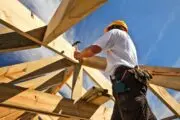
Ontario voters are getting ready to head to the polls on June 2nd, and fixing the province’s chronic shortage of housing appears to be a major consideration among electorates this time.
In a recent Market Trends blog post, Royal LePage revealed that a large portion of Ontarians who are voting age believe that confronting the housing supply crisis should be a top priority for the next provincial government.
In an online Royal LePage survey conducted by Leger with 1,021 Ontario adult residents, participants were asked to respond to the statement, “A party’s position on housing supply and affordability is a top consideration in my voting decision in the upcoming provincial election.”
The majority of those surveyed (63 per cent) said that they agreed with the statement — 22 per cent answered that they strongly agreed and the other 41 per cent of participants said that they somewhat agreed with the statement. In the City of Toronto specifically, the quantity of those surveyed who agreed with the statement rose to 69 per cent.
Twenty-seven per cent of Ontario participants said they disagreed with the statement, and the remaining 10 per cent responded “I don’t know.”
“The pandemic triggered a willingness to spend more on housing as the family home took on heightened importance. The real estate boom that resulted has worsened an already critical housing shortage in this country and Canadians are demanding action,” said Phil Soper, president and CEO of Royal LePage, in the company’s blog post.
“In Ontario, achieving home ownership has been especially challenging, given the strong organic demand generated from new household formation and the large number of newcomers that the province welcomes each year,” he added.
The four main Ontario political parties have laid out their strategies for improving the province’s housing supply. In addition to building new homes, the platforms in this provincial election detail plans to change zoning rules, enhance consumer protections for resale and new construction buyers, and introduce speculation and vacancy taxes.
The conversations around housing supply and affordability have been swirling in Ontario for some time.
In October 2021, the Smart Prosperity Institute stated that Ontario would need to provide one million new residences within the next 10 years in order to meet market demand. In its research paper, the Ottawa-based research and policy think tank determined that 910,000 homes are required for the formation of new households, plus 65,000 units of housing to address current supply gaps and 25,000 properties for additional population growth.
Months later, Scotiabank revealed in a report that Ontario’s per capita housing stock was below the national average, and would require over 650,000 additional housing units to catch up with its fellow provinces.
In February, Ontario released its Housing Affordability Task Force report which provided recommendations to build 1.5 million homes over the next 10 years. To aid this process, the Task Force put forward suggestions to lower development costs and reduce red tape, which includes limiting exclusionary zoning in municipalities by permitting as-of-right residential housing and waiving development charges and parkland cash-in-lieu on all infill residential projects up to 10 units.






